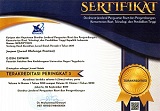The effects of the wobble board on archery accuracy at 30 meters for archers
Abstract
This research aims to determine whether wobble board training methods affect shooting accuracy in
archers at a distance of 30 meters. This research uses a quasi-experimental method with a One Group
Pretest-Posttest Design. The research sample consisted of 12 archers aged 15–18 years, selected from
the SELABORA Archery of FIK UNY. The instrument used was archery at a 30 meters distance. The
data analysis technique employed Normality Test using SPSS 25 software, followed by a Homogeneity
Test to determine whether sample variances derived from the same population were equal. Based on the
research findings and discussion: Based on the analysis of the archery accuracy data of SELABORA
Archery FIK UNY, the calculated t value (5,437) > t table (2,20), and the p value (0,000) < of 0.05.
Therefore, it can be concluded that wobble board training significantly affects archery accuracy at 30
meters among SELABORA Archery FIK UNY.
Downloads
Published
How to Cite
Issue
Section
License
Copyright (c) 2025 Septian Resi, Rekyan Woro Mulaksito Mulyadi, Agung Wahyu Nugroho, Sunaryo, Wisnu Nugroho, Arif Kurniawan, Muh. Batistuta Fitoni Nuradila, Candra Widyastuti

This work is licensed under a Creative Commons Attribution-ShareAlike 4.0 International License.
Authors who publish with this journal agree to the following terms:
- Authors retain copyright and grant the journal right of first publication with the work simultaneously licensed under a Creative Commons Attribution License that allows others to share the work with an acknowledgement of the work's authorship and initial publication in this journal.
- Authors are able to enter into separate, additional contractual arrangements for the non-exclusive distribution of the journal's published version of the work (e.g., post it to an institutional repository or publish it in a book), with an acknowledgement of its initial publication in this journal.
- Authors are permitted and encouraged to post their work online (e.g., in institutional repositories or on their website) prior to and during the submission process, as it can lead to productive exchanges, as well as earlier and greater citation of published work (See The Effect of Open Access).




